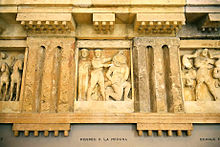Metope (architecture)

In architecture, the space between two triglyphs in the Doric frieze or in the triglyph frieze is referred to as a metope ( ancient Greek μετόπη metópē , German 'between the opening [of the triglyphs]' ) . This space can either be open or closed with intermediate fields.
Ancient architecture
The triglyph frieze is part of the Doric order that existed in ancient Greece in the 7th century BC. BC and was mainly used in temple architecture . But also later the Doric order and with it the metopes were used as a dividing and decorative principle of order in Greek architecture . In the early days, the metopes were open and could be decorated with vases or sacrificial animal skulls. Later, the open spaces were closed with panels made of different materials. These plates could be painted or provided with reliefs .
The metopes as separated individual images, which could usually contain a maximum of three figures, usually represented individual scenes from a larger context. Scenes are rarely distributed over several metopes, it is preferred to pick out scenes from a higher-level action, especially combat, and thus develop the whole Happening. Other thematic connections could also be illustrated in this way. For example, the metopes from the Temple of Zeus in Olympia above the cella showed the twelve deeds of Heracles , six on each side of the temple. Individual mythical scenes such as the robbery of Europe or the kidnapping of a herd of cattle by the Dioscuri were just as much part of the depiction as scenes from the Argonaut saga or the Trojan War . The battles against Centaurs , the Amazons , the giants , such as those encountered at the Parthenon in Athens, recur at many temples. Some of the reliefs are of great artistic value, for example the metopes of the Parthenon in Athens .
From a structural point of view, metopes can be worked with an adjacent triglyph from a workpiece. Most of the time, however, they are formed as independent plates that are embedded between the triglyphs. Most of them are almost square, but could be clearly rectangular or wide. Due to the Doric corner conflict , the metopes on one side of the building could be of different widths. As a possible solution to the conflict, only the corner metopes were widened. If, on the other hand, the corner contraction of the column position was used and this was distributed over two column yokes , several neighboring metopes could also be affected.
Romanesque architecture
The fields between the stone beam ends of the Romanesque console friezes are also called 'metopes' in specialist literature. They are mostly undecorated, but - especially in the south-west of France and northern Spain - they can be decorated with ornamental, and more rarely with figurative motifs.
literature
- Walter Hatto Gross : Metope 2). In: The Little Pauly (KlP). Volume 3, Stuttgart 1969, column 1279.
- Luca Giuliani: The Archaic Metopes of Selinunt. von Zabern, Mainz 1979, ISBN 3-8053-0287-8 .
- Heinz Kähler: The Greek metope image. Münchner verlag, Munich 1949.



